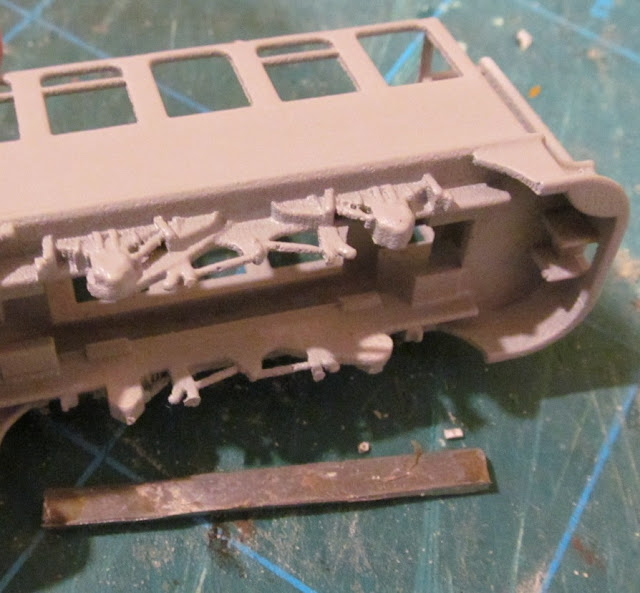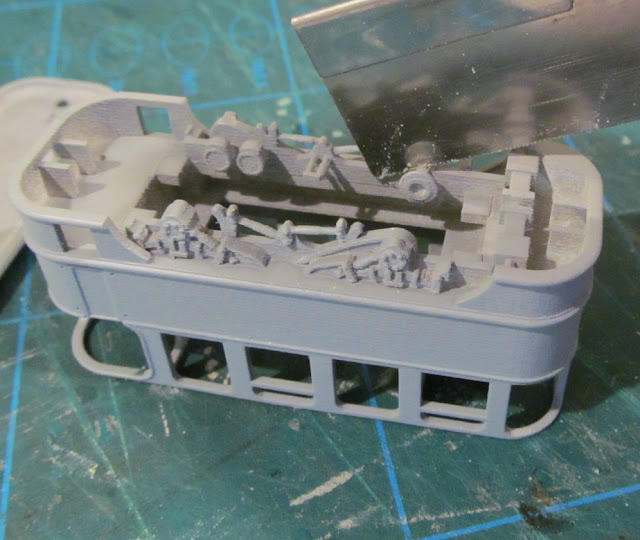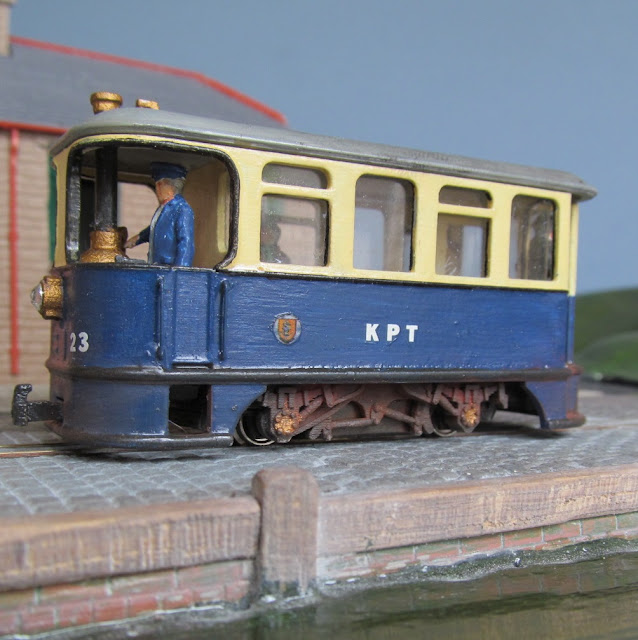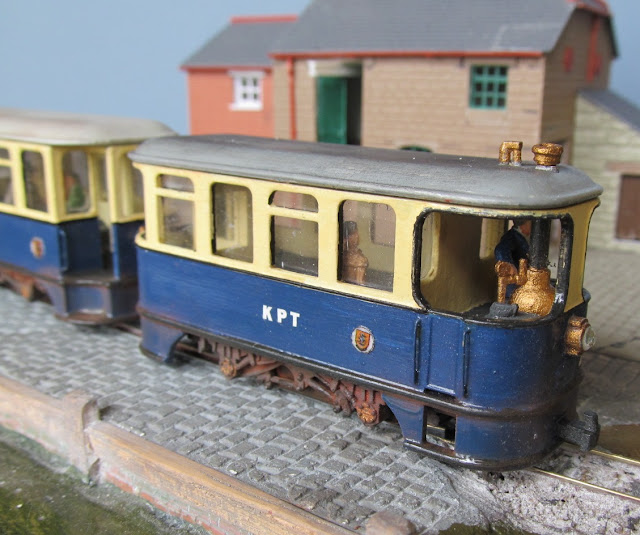 |
|
© 2018 David Hurst
All Rights Reserved
|
009 K.P. Tramcars
These are what might have been “tramcars”. One is a vertical boiler style steam tramcar, based on an Atkinson Walker steam wagon, combined with a generic electric tramcar, the other a generic double ended electric style tramcar which can be seen in many locations worldwide and can also be used as a dummy car or coach. The tram may have been used on some of the smaller country or seaside tram lines, which were looking for an economical passenger or mixed traffic tractor around the turn of the 19th century.
The coach or dummy car which can be used as an electric tram or a small coach to pull along behind the K.P. steam tramcar or a suitable engine can run on the Kato 11-104 chassis or a dummy free wheeler chassis.
These are what might have been “tramcars”. One is a vertical boiler style steam tramcar, based on an Atkinson Walker steam wagon, combined with a generic electric tramcar, the other a generic double ended electric style tramcar which can be seen in many locations worldwide and can also be used as a dummy car or coach. The tram may have been used on some of the smaller country or seaside tram lines, which were looking for an economical passenger or mixed traffic tractor around the turn of the 19th century.
Both tramcars
have been designed to use the Kato 11-104 chassis with some modification. The
roof is removable to allow interior details to be added, and they also have some
detailed parts printed with the model. These include a representation of a
vertical boiler whistle, funnel cap, (K.P. steam tram only), running lamps, and
a pair of couplings (on both trams).
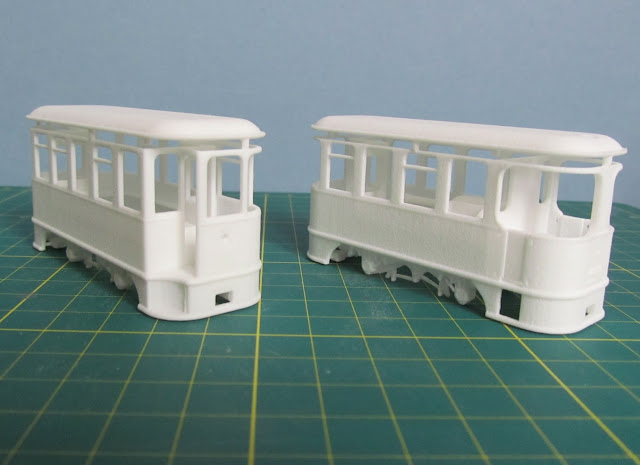 |
|
© 2018 David Hurst
All Rights Reserved
|
The coach or dummy car which can be used as an electric tram or a small coach to pull along behind the K.P. steam tramcar or a suitable engine can run on the Kato 11-104 chassis or a dummy free wheeler chassis.
Cleaning and priming
If you have a
print in Smooth Fine Detail Plastic it is advisable to soak in petroleum spirits (paint
thinners/cleaner). This is to remove the oil based wax support residue left
from printing. Next wash in warm soapy water and allow to fully dry which should
leave the surface ready for painting. I use a grey or white spray primer to
prep the model for finishing, but in some areas it will be necessary to remove
print lines from the surface, and this can be done with a burnishing tool. I
use a hardwood stick with a rounded point to get in the tight spaces.
Wirework
There is not a great amount of wirework on these models, just the hand rails each side of the cab door openings and at the passenger’s entrance. For this I have used 0.45 mm brass wire, and drilled out the pilot holes to suit. The cab handrails are formed as four U shaped pieces which I pushed through the pre-drilled holes from the outside and fixed with Cyanoacrylate glue (super glue). The passenger’s entrance has one U shaped piece and one full height pole fitted between the floor and roof. This can be fitted when the roof is fixed in place.
Fitting the chassis & ballast
The Kato chassis will need to be cut down to fit, the coupling mounts need to be cut off each end and the axel boxes will need to be removed from the sides. I have added two small lead weights at each end of the chassis glued in place, also some strips of lead inside the cabin to each side of the chassis opening. This has been enough ballast to give the model good electrical pick up and traction.
Couplings
A Pair of printed couplings are supplied with these models. They are printed under the footplate, along with the other small detail parts such as the work lamps.
Glazing
For the windows I have used thin acetate saved from old packaging;
this is glued with Cyanoacrylate glue (super glue). It is great if you have
curved or awkward shaped glazing as the acetate being thin and flexible can be persuaded
to take on a curve by passing it between a smooth round surface like a screw
driver shaft and your thumb. I fit the glazing when building the model and then
fix it in place in the final stages after the painting is completed and before the
roof is fitted. Any weathering is done after the glazing is completed.
Interior details
After initial preparation of the model it was given a couple of light coats of matt grey primer, then burnished and smoothed, with a final coat of primer to finish off. As there is no prototype to guide us with this model, I chose to do the footplate, roof and handrails, in a charcoal grey Revel No 09. I dry brushed a little silver round the mechanical parts under the footplate which highlights the details; also some gloss varnish gives the impression of oil on these areas. The body on these models have been done in yellow cream at window level and a dark blue below. The impression of rust was added to some areas of the footplate, buffer beams and running gear with a dry brushed application of Revel Matt No 37 and No 85.
The final little bit of detail was to add the work lamps and lenses. For these I used 3mm Clear Rhinestones, fitted after painting was completed..
If you would like a copy of this model it is available on Shapeways at Model Engine Works:
The K.P. steam tram has a vertical boiler; water tanks, feed pipes and
gauge printed within the passenger cabin. This will need removing and then details
such as wheel valves and additional pipework can be added. This type of small
tram is likely to have had side benches for passenger seating, so figures
adjusted to suit the internal floor level can be added with their backs to the
windows to represent passengers.
 |
|
© 2018 David Hurst
All Rights Reserved
|
Painting
After initial preparation of the model it was given a couple of light coats of matt grey primer, then burnished and smoothed, with a final coat of primer to finish off. As there is no prototype to guide us with this model, I chose to do the footplate, roof and handrails, in a charcoal grey Revel No 09. I dry brushed a little silver round the mechanical parts under the footplate which highlights the details; also some gloss varnish gives the impression of oil on these areas. The body on these models have been done in yellow cream at window level and a dark blue below. The impression of rust was added to some areas of the footplate, buffer beams and running gear with a dry brushed application of Revel Matt No 37 and No 85.
The final little bit of detail was to add the work lamps and lenses. For these I used 3mm Clear Rhinestones, fitted after painting was completed..
I finished
over all areas with a coat of matt varnish. I then added weathering with powdered
wax pastels, using mixes of orange, brown and black, to give the tram an
overall weathered and well- used appearance.
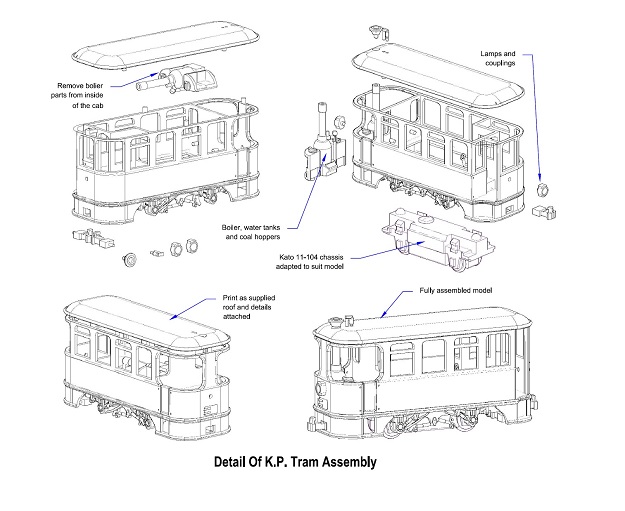 |
| © 2018 David Hurst All Rights Reserved |
 |
| © 2018 David Hurst All Rights Reserved |
If you would like a copy of this model it is available on Shapeways at Model Engine Works:


